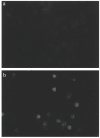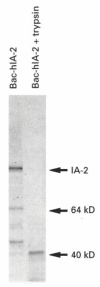Expression, characterization, processing and immunogenicity of an insulin-dependent diabetes mellitus autoantigen, IA-2, in Sf-9 cells
- PMID: 9737664
- PMCID: PMC1905060
- DOI: 10.1046/j.1365-2249.1998.00676.x
Expression, characterization, processing and immunogenicity of an insulin-dependent diabetes mellitus autoantigen, IA-2, in Sf-9 cells
Abstract
Autoantibodies to a 64-kD protein and a 40-kD tryptic fragment from pancreatic islets have been detected at high frequency in the sera of patients with insulin-dependent diabetes mellitus (IDDM). IA-2, a newly isolated transmembrane protein tyrosine phosphatase, is a major islet cell autoantigen in IDDM and the precursor of a 40-kD tryptic fragment. To express large quantities of recombinant IA-2 protein and analyse post-translational modifications we expressed full-length human IA-2 in baculovirus-infected Sf-9 cells. IA-2 expression was analysed by Western blot and by immunoprecipitation of 35S-methionine-radiolabelled proteins with rabbit antisera or IDDM sera. A 120-kD IA-2 protein was detected during the early, but not the late, phase of the infection. Pulse-chase experiments showed that the 120-kD protein was processed into fragments of 64 kD and smaller fragments of approximately 50 kD, 38 kD and 32 kD. The 64-kD fragment appeared as a doublet. Tunicamycin and PNGase F treatment down-shifted the 120-kD protein and the 64-kD doublet into lower molecular weight bands, suggesting that both were glycosylated. Trypsin treatment converted the 120-kD protein and the 64-kD doublet into a 40-kD fragment. Baculovirus-expressed IA-2 was as sensitive or slightly more sensitive than in vitro translated IA-2 in detecting autoantibodies to IA-2: 66% of sera from newly diagnosed IDDM patients reacted with baculovirus-expressed IA-2 compared with 59% of the same sera which reacted with in vitro translated IA-2. It is concluded that baculovirus-expressed IA-2 is a good source of autoantigen and that a number of lower molecular weight fragments with which IDDM autoantibodies react are derived from the 120-kD full-length IA-2 molecule.
Figures









Similar articles
-
The 37/40-kilodalton autoantigen in insulin-dependent diabetes mellitus is the putative tyrosine phosphatase IA-2.Proc Natl Acad Sci U S A. 1995 Sep 26;92(20):9412-6. doi: 10.1073/pnas.92.20.9412. Proc Natl Acad Sci U S A. 1995. PMID: 7568143 Free PMC article.
-
IA-2, a transmembrane protein of the protein tyrosine phosphatase family, is a major autoantigen in insulin-dependent diabetes mellitus.Proc Natl Acad Sci U S A. 1996 Jun 25;93(13):6367-70. doi: 10.1073/pnas.93.13.6367. Proc Natl Acad Sci U S A. 1996. PMID: 8692821 Free PMC article.
-
Identification of a second transmembrane protein tyrosine phosphatase, IA-2beta, as an autoantigen in insulin-dependent diabetes mellitus: precursor of the 37-kDa tryptic fragment.Proc Natl Acad Sci U S A. 1996 Mar 19;93(6):2307-11. doi: 10.1073/pnas.93.6.2307. Proc Natl Acad Sci U S A. 1996. PMID: 8637868 Free PMC article.
-
IA-2 and IA-2beta: the immune response in IDDM.Diabetes Metab Rev. 1998 Mar;14(1):85-93. doi: 10.1002/(sici)1099-0895(199803)14:1<85::aid-dmr205>3.0.co;2-i. Diabetes Metab Rev. 1998. PMID: 9605631 Review.
-
Autoimmune diabetes: the role of T cells, MHC molecules and autoantigens.Autoimmunity. 1998;27(3):159-77. doi: 10.3109/08916939809003864. Autoimmunity. 1998. PMID: 9609134 Review.
Cited by
-
Structural genomics of protein phosphatases.J Struct Funct Genomics. 2007 Sep;8(2-3):121-40. doi: 10.1007/s10969-007-9036-1. Epub 2007 Dec 5. J Struct Funct Genomics. 2007. PMID: 18058037 Free PMC article. Review.
-
IA-2 modulates dopamine secretion in PC12 cells.Mol Cell Endocrinol. 2010 Feb 5;315(1-2):81-6. doi: 10.1016/j.mce.2009.09.023. Epub 2009 Sep 30. Mol Cell Endocrinol. 2010. PMID: 19799965 Free PMC article.
-
A new ELISA for dermatomyositis autoantibodies: rapid introduction of autoantigen cDNA to recombinant assays for autoantibody measurement.Clin Dev Immunol. 2013;2013:856815. doi: 10.1155/2013/856815. Epub 2013 Dec 12. Clin Dev Immunol. 2013. PMID: 24416061 Free PMC article. Review.
-
Small cell lung cancer growth is inhibited by miR-342 through its effect of the target gene IA-2.J Transl Med. 2016 Sep 26;14(1):278. doi: 10.1186/s12967-016-1036-0. J Transl Med. 2016. PMID: 27670444 Free PMC article.
-
The dense core transmembrane vesicle protein IA-2 is a regulator of vesicle number and insulin secretion.Proc Natl Acad Sci U S A. 2005 Jun 14;102(24):8704-9. doi: 10.1073/pnas.0408887102. Epub 2005 Jun 6. Proc Natl Acad Sci U S A. 2005. PMID: 15939893 Free PMC article.
References
-
- Atkinson MA, Maclaren NK. The pathogenesis of insulin-dependent diabetes mellitus. N Engl J Med. 1994;331:1427–36. - PubMed
-
- Bonifacio E, Bingley PJ, Shattock M, Dean BM, Dunger D, Gale EAM, Bottazzo GF. Quantification of islet-cell antibodies and prediction of insulin-dependent diabetes. Lancet. 1990;335:147–9. - PubMed
-
- Christie MR, Tun RY, Lo SS, et al. Antibodies to GAD and tryptic fragments of islet 64K antigen as distinct markers for development of IDDM. Studies with identical twins. Diabetes. 1992;41:782–7. - PubMed
-
- Christie MR, Genovese S, Cassidy D, Bosi E, Brown TJ, Lai M, Bonifacio E, Bottazzo GF. Antibodies to islet 37k antigen, but not to glutamate decarboxylase, discriminate rapid progression to IDDM in endocrine autoimmunity. Diabetes. 1994;43:1254–9. - PubMed
MeSH terms
Substances
LinkOut - more resources
Full Text Sources
Medical

